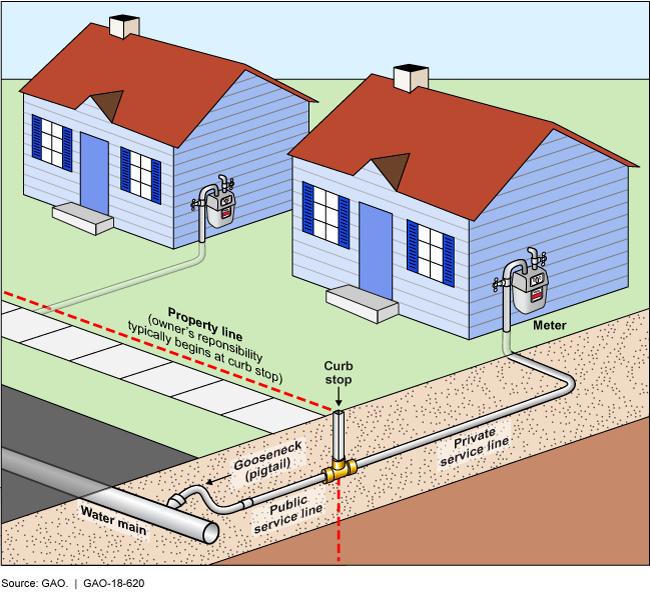Drinking Water: Approaches For Identifying Lead Service Lines Should Be Shared With All States
Fast Facts
The water crisis in Flint, Michigan, highlighted dangers of lead in drinking water infrastructure. Lead enters drinking water primarily from old service lines between water mains and houses or buildings. The total number of lead service lines across the country is unknown.
EPA asked states to publicize information about known locations of lead service lines. However, we found most of the largest water systems have not done so.
We recommended that EPA share information on approaches for counting lead service lines with all states.
Typical location of water main, lead service line, and other pipes that deliver drinking water to homes

Picture of two homes with location of water main, lead service line, and other pipes that deliver drinking water.
Highlights
What GAO Found
The total number of lead service lines is unknown and while national, state, and local estimates exist, approaches used to count lead service lines vary. A 2016 American Water Works Association study estimated that nationally there were 6.1 million lead service lines, but the study has significant sampling limitations and, as a result, likely does not accurately reflect the total number of lead service lines nationwide. In addition, at least two statesMassachusetts and Washingtonpublished reports with estimates of lead service lines and reported 22,023 and 1,000-2,000 lead service lines as of 2016 and 2017, respectively. Certain water systems also have estimates, such as the approximately 7 percent of publicly owned lead service lines out of the area's total number of service lines cited by a representative for the system serving Cincinnati, Ohio and surrounding areas, as of May 2018.
Typical Location of Lead Service Line and Other Pipes That Deliver Drinking Water

While most states informed the Environmental Protection Agency (EPA) that they intend to fulfill the agency's request to publicize inventories of lead service lines, EPA has identified potential challenges to these efforts. Of the approximately 43 states that responded that they would fulfill EPA's request, almost all (39) reported to EPA that, although they had encouraged water systems to publicize inventories, few systems had completed these actions. GAO found in January 2018 that, of the 100 largest water systems, 12 had publicized information on the inventory of lead service lines. According to EPA, among challenges in conducting inventories of lead service lines and publicizing information about lead service lines were concerns about posting on public websites information about lead service lines on private property; and a lack of records about the locations of lead service lines. EPA told GAO the agency was focused on state compliance with drinking water rules, and not following up with information on how states could address the challenges cited. By sharing information with all states about the approaches that some states and water systems are using to successfully identify and publicize information about lead service lines, including responses to potential challenges, EPA could encourage states to be more transparent to the public and support the agency's objectives for safe drinking water.
Why GAO Did This Study
The crisis in Flint, Michigan, brought increased attention to lead in drinking water infrastructure. Lead in drinking water primarily comes from corrosion of service lines connecting the water main to a house or building. In 1991, EPA issued the Lead and Copper Rule that required water systems to conduct a “materials inventory” of lead service lines. In light of the events in Flint, EPA sent a letter to all states in February 2016 encouraging them to work with water systems to publicly post the materials inventory, along with any additional updated maps or inventories of lead service linesactions the rule does not require.
A House Committee report accompanying a bill for the Department of the Interior, Environment and Related Agencies Appropriations Act, 2017, includes a provision for GAO to review lead service lines. This report examines (1) what is known about the number of existing lead service lines among states and water systems and (2) states' responses to EPA's February 2016 request to work with water systems to publicize inventories of lead service lines and any steps EPA has taken to follow up on these responses. GAO reviewed existing studies of lead service lines, reviewed the websites of the 100 largest water systems, and interviewed EPA officials in headquarters and its 10 regional offices.
Recommendations
GAO recommends that EPA share information about the successful approaches states and water systems use to identify and publicize locations of lead service lines with all states. EPA agreed with the recommendation.
Recommendations for Executive Action
| Agency Affected | Recommendation | Status |
|---|---|---|
| Office of Water | The Assistant Administrator for Water of EPA's Office of Water should share information with all states about the approaches that some states and water systems are using to successfully identify and publicize information on lead service lines, including responses to potential challenges. (Recommendation 1) | In July 2019, EPA provided information regarding this recommendation. Specifically, EPA stated that the agency posted, on its public website, a series of webinars that showcase best practices for states and water systems implementing voluntary lead service line replacement programs. According to EPA's website, the first two webinars in the series, in March and June 2019, focused on experiences in lead service line replacement by water systems and states, and included a discussion of challenges. The next two webinars scheduled for September and December 2019 focus on large and small water systems, according to EPA's website. EPA also stated that it features, on its public website, a story... map that showcases water systems and communities in various parts of the country that are removing lead service lines. Based on the information provided, GAO considers this recommendation implemented.
View More |
